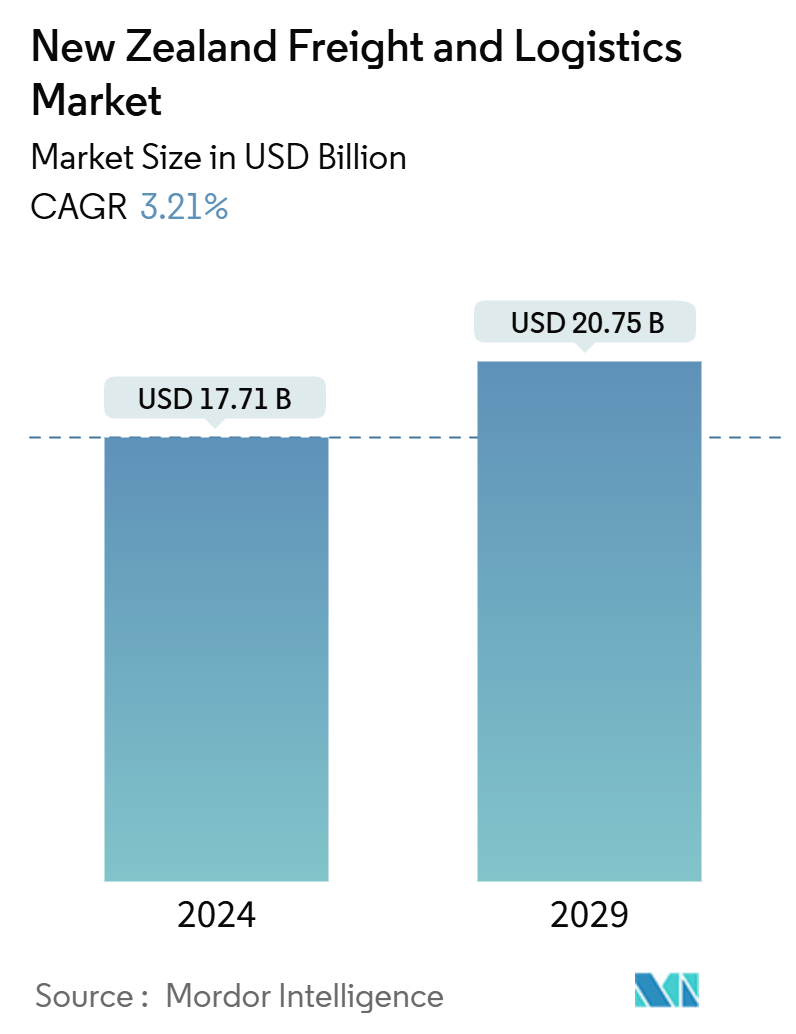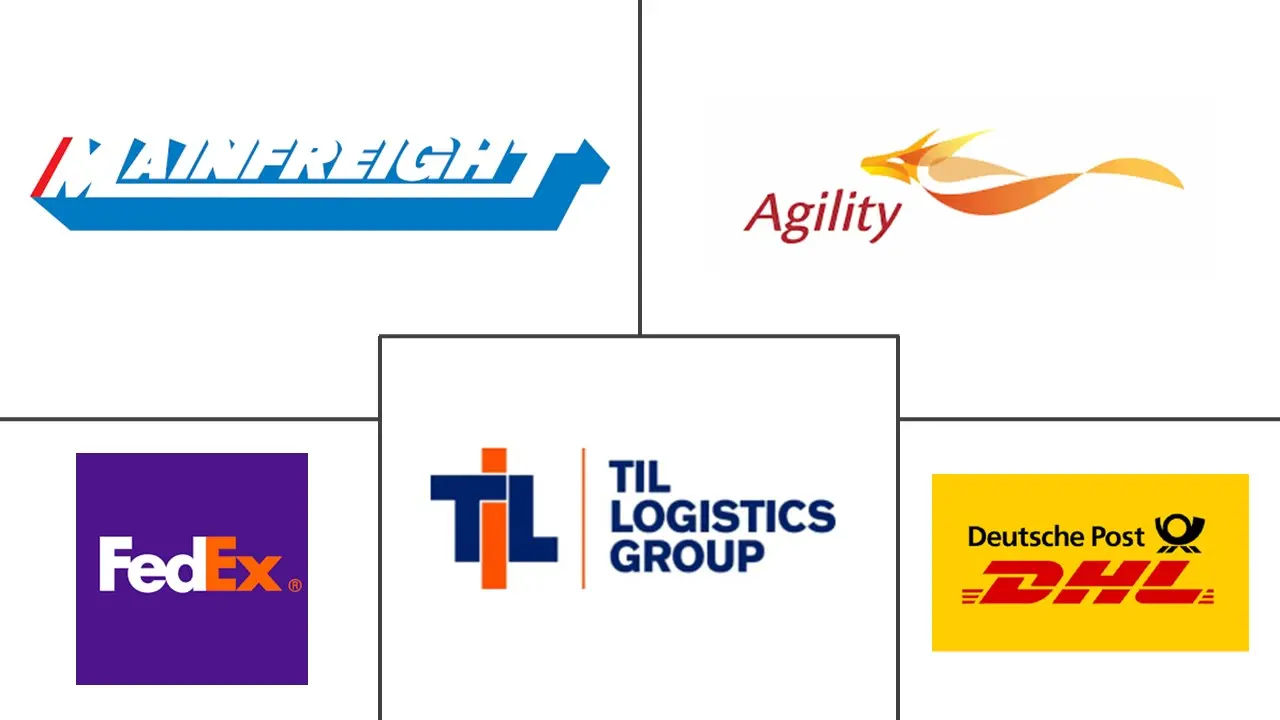Market Size of New Zealand Freight And Logistics Industry

| Study Period | 2020 - 2029 |
| Base Year For Estimation | 2023 |
| Market Size (2024) | USD 17.71 Billion |
| Market Size (2029) | USD 20.75 Billion |
| CAGR (2024 - 2029) | 3.21 % |
| Market Concentration | Low |
Major Players
*Disclaimer: Major Players sorted in no particular order |
New Zealand Freight And Logistics Market Analysis
The New Zealand Freight And Logistics Market size is estimated at USD 17.71 billion in 2024, and is expected to reach USD 20.75 billion by 2029, at a CAGR of 3.21% during the forecast period (2024-2029).
- In the Waikato region, vital transport corridors like State Highway 1 and the main trunk rail line underscore the significance of the Freight and Logistics sector as a key economic driver. In New Zealand, road freight leads the way, constituting nearly 70% of freight movement by ton-kilometre and surpassing 90% by volume. While rail may be on a smaller scale, it plays a crucial role in connecting major cities such as Auckland, Tauranga, and Hamilton.
- Looking forward, projections indicate that over 90% of freight will continue to be road-based. The Golden Triangle region, encompassing Auckland, Tauranga, and Hamilton, is set to manage 42% of the nation's total freight. This demand surge over the next 25 years is attributed to population growth and economic expansion. Between 2020 and 2030, freight volumes in the Waikato and Bay of Plenty regions could witness a rise of 47% to 65%, underscoring the urgent need for enhanced logistics infrastructure and workforce development.
- In Waikato, the sector boasts a workforce of over 7,000, with a pronounced demand for skilled positions such as truck drivers and logistics planners. The workforce leans male and is predominantly low-skilled, increasingly leaning on migrant labor, especially in postal and courier services. Yet, challenges loom with intensifying workforce shortages in truck driving and logistics. In response, there's a concerted effort to expand training programs and higher education avenues.
- A pivotal initiative, the Freight Action Plan for the Golden Triangle, underscores the urgency to bolster network capacity, tackle skills shortages, and adopt emerging technologies like hydrogen. While the sector stands on the brink of growth, it grapples with challenges in workforce attraction and infrastructure expansion.
New Zealand Freight And Logistics Industry Segmentation
Freight and logistics refer to the transportation of goods in the domestic and international markets via various modes of transportation, including air, rail, and roadways.
The report includes a complete background analysis of the New Zealand freight and logistics market, including an assessment of the economy and the contribution of sectors to the economy, a market overview, market size estimation for key segments, emerging trends in the market segments, market dynamics, and geographical trends.
The New Zealand Freight and Logistics Market is segmented by function (freight transport [air, shipping, and inland water, road, and rail], freight forwarding, warehousing, and value-added services and other functions) and end-user (manufacturing and automotive, oil and gas, mining, and quarrying, agriculture, fishing, and forestry, construction, distributive trade [wholesale and retail], and other end users [telecommunication, pharmaceuticals, and F&B]).
The report offers market size and forecasts for the New Zealand freight and logistics market in terms of value (USD) for all the above segments.
| By Function | ||||||
| ||||||
| Freight Forwarding | ||||||
| Warehousing | ||||||
| Value-added Services and Other Functions |
| By End-User | |
| Manufacturing and Automotive | |
| Oil and Gas, Mining, and Quarrying | |
| Agriculture, Fishing, and Forestry | |
| Construction | |
| Distributive Trade (Wholesale and Retail Segments (FMCG Included)) | |
| Other End-Users (Telecommunication, Pharmaceuticals, and F&B) |
New Zealand Freight And Logistics Market Size Summary
The New Zealand freight and logistics market is poised for steady growth over the forecast period, driven by a combination of local demand and export activities. The market is characterized by a significant reliance on road freight, which dominates domestic freight movement, while rail transport plays a crucial role in connecting key urban centers. The pandemic-induced supply chain disruptions have led to shifts in consumer behavior, with increased support for local suppliers and a focus on agricultural exports such as dairy and meat products. However, challenges remain, including capacity issues at ports and erratic shipping schedules, which have impacted the efficiency of the domestic supply chain. Despite these challenges, the market continues to benefit from government subsidies and a robust local demand for goods.
The market landscape is fragmented, with a mix of international and local players competing for market share. Companies like Mainfreight Limited and TIL Logistics Group Limited are prominent in the road freight sector, contributing to the competitive environment. Recent acquisitions, such as Qube Holdings' stake in Pinnacle Corporation and Lineage Logistics' expansion in New Zealand, highlight the ongoing consolidation and strategic investments in the sector. New Zealand's eCommerce sector also presents growth opportunities, with increasing online penetration and a diverse range of popular product categories. As the market evolves, it is expected to adapt to global economic trends and local consumer preferences, ensuring continued expansion and development.
New Zealand Freight And Logistics Market Size - Table of Contents
-
1. MARKET INSIGHTS
-
1.1 Current Market Scenario
-
1.2 Technological Developments in the Market
-
1.3 Government Regulations and Initiatives
-
1.4 Industry Value Chain/Supply Chain Analysis
-
1.5 Brief on Freight Transportation Costs/Freight Rates in New Zealand
-
1.6 Spotlight on the E-commerce Market
-
1.7 Brief on the 3PL Market in New Zealand
-
1.8 Insights into the Courier, Express, and Parcel (CEP) Market
-
1.9 Demand and Supply Analysis
-
1.10 Commentary on Trucking Operating Costs
-
1.11 Spotlight on Key Logistics Hubs and Cities in New Zealand
-
1.12 Impact of Geopolitics and Pandemic on the Market
-
-
2. MARKET SEGMENTATION
-
2.1 By Function
-
2.1.1 Freight Transport
-
2.1.1.1 Road
-
2.1.1.2 Shipping and Inland Water
-
2.1.1.3 Air
-
2.1.1.4 Rail
-
-
2.1.2 Freight Forwarding
-
2.1.3 Warehousing
-
2.1.4 Value-added Services and Other Functions
-
-
2.2 By End-User
-
2.2.1 Manufacturing and Automotive
-
2.2.2 Oil and Gas, Mining, and Quarrying
-
2.2.3 Agriculture, Fishing, and Forestry
-
2.2.4 Construction
-
2.2.5 Distributive Trade (Wholesale and Retail Segments (FMCG Included))
-
2.2.6 Other End-Users (Telecommunication, Pharmaceuticals, and F&B)
-
-
New Zealand Freight And Logistics Market Size FAQs
How big is the New Zealand Freight And Logistics Market?
The New Zealand Freight And Logistics Market size is expected to reach USD 17.71 billion in 2024 and grow at a CAGR of 3.21% to reach USD 20.75 billion by 2029.
What is the current New Zealand Freight And Logistics Market size?
In 2024, the New Zealand Freight And Logistics Market size is expected to reach USD 17.71 billion.

